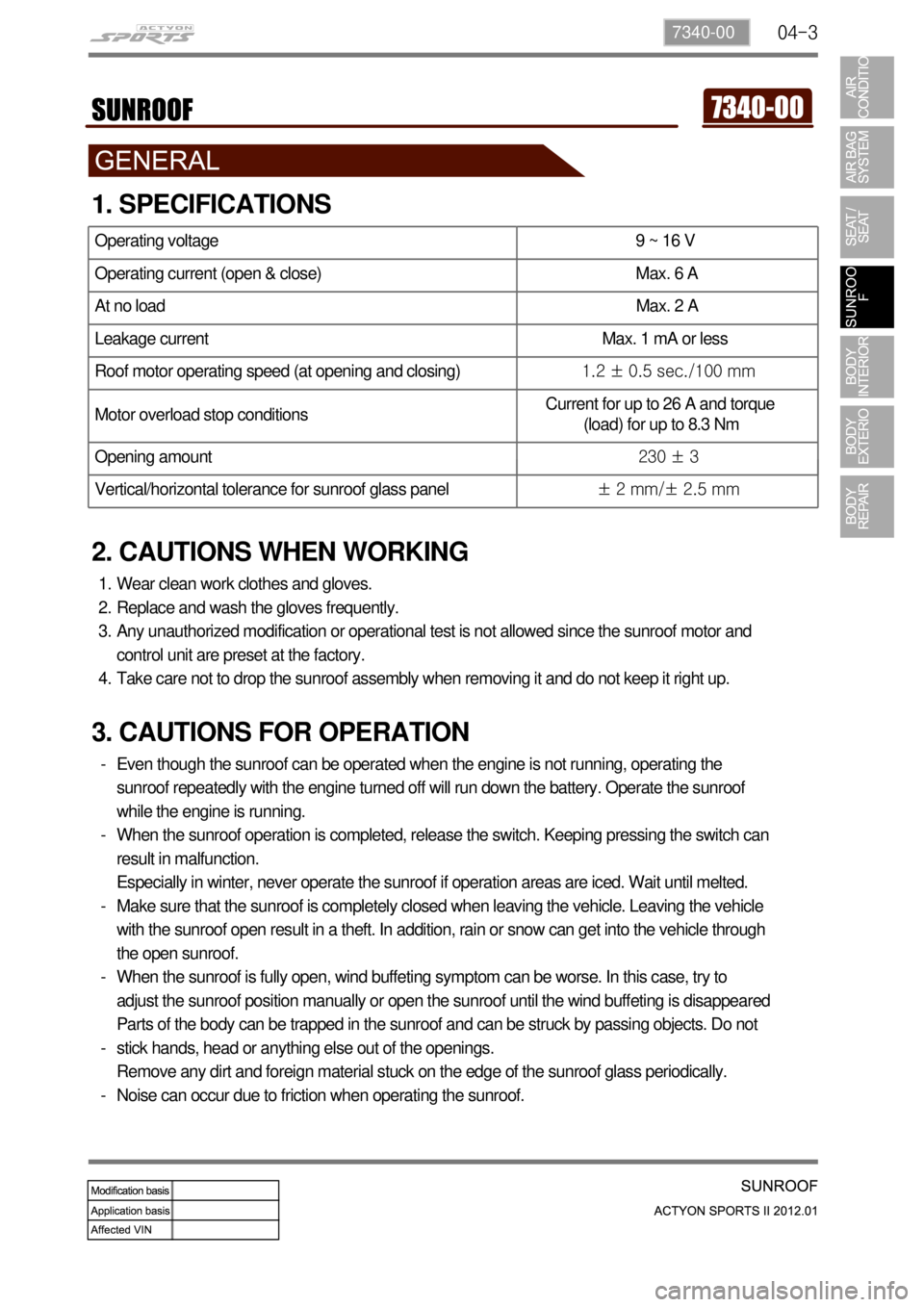torque SSANGYONG NEW ACTYON SPORTS 2012 Workshop Manual
[x] Cancel search | Manufacturer: SSANGYONG, Model Year: 2012, Model line: NEW ACTYON SPORTS, Model: SSANGYONG NEW ACTYON SPORTS 2012Pages: 828, PDF Size: 91.28 MB
Page 758 of 828

13-174170-09
If weight is not equally distributed around the wheel, unbalance centrifugal force by the wheel
rotation produces vibration. As the centrifugal force is produced proportional to the square of the
rotating speed, the wheel weight should be balanced even at high speed. There are two types of
the tire and wheel balancing: static and dynamic. Abnormal vibration may also occur due to
unbalanced rigidity or size of tires.
Static Balance ▶
When the free rotation of the wheel is
allowed, the heavier part is stopped on the
bottom if the wheel weight is unbalanced and
this is called "Static Unbalance". Also, the
state at which tire's stop position is not same
is called "Static Balance" when the wheel is
rotated again. If the part A is heavier as
shown in the figure 1, add the balance weight
of a weight corresponding to unbalanced
weight from B to A to maintain the static
balance. If the static balance is not
maintained, tramping, up and down vibration
of the wheels, occurs.
Dynamic Balance ▶
The static unbalance of the wheel creates the
vibration in the vertical direction, but the
dynamic unbalance creates the vibration in
the lateral direction. As shown in the figure 2
(a), if two parts, (2) and (3), are heavier when
the wheels are under the static balance
condition, dynamic unbalance is created,
resulting in shimmy, left and right vibration of
the wheels, and the torque Fxa is applied in
the axial direction. To correct the dynamic
unbalance, add the balance weight of a same
weight for two points of the circumference of
the rim, A and B, as shown in the figure 2 (b),
and apply the torque in the opposite direction
to the torque Fxa to offset in order to ensure
smooth rotation of the wheel.
Center
A
B
(a) (b)
[Figure 1]
[Figure 2]
3. WHEEL BALANCE
Page 812 of 828

03-157430-01
Working Diagram Operation
Basic Operating Process ▶
MGG is ignited and the piston moves up by the
gas pressure.
The rack gear is engaged to the piston. This
changes the linear movement to rotational
movement.
When the piston is rotating, the roller moves to
shaft according to the cam shape of pinion. At
this moment, the clutch is engaged.
The combined set of pinion, sleeve and spool
rotates as a set. -
-
-
-
The piston moves up by
the gas pressure and
pulls in the belt by
rotating the spool. -
If the shaft torsion starts to deformed due to
increased load to the passenger, the spool
and pinion (clutch assembly) rotates in reverse
and the psiton moves down.
The psiton moves down when the residual
pressure is eliminated through vent hole. If it
reaches to the bottom, the pinion is
disengaged and rotates freely. -
- Initial position 1.
Inflator ignited
(inner clutch
engaged) 2.
Piston moved to
top position 3.
Load limiter
operated (rack
moved to
opposite
direction) 4.
Rotation of sleeve Tha gap netween
roller and sleeve
is maintained.
Thus, the sleeve
transfers the reel
spring torque to
the spool when it
is rotated. -
Page 816 of 828

04-37340-00
1. SPECIFICATIONS
2. CAUTIONS WHEN WORKING
Wear clean work clothes and gloves.
Replace and wash the gloves frequently.
Any unauthorized modification or operational test is not allowed since the sunroof motor and
control unit are preset at the factory.
Take care not to drop the sunroof assembly when removing it and do not keep it right up. 1.
2.
3.
4.
Operating voltage 9 ~ 16 V
Operating current (open & close) Max. 6 A
At no load Max. 2 A
Leakage current Max. 1 mA or less
Roof motor operating speed (at opening and closing)1.2 ± 0.5 sec./100 mm
Motor overload stop conditionsCurrent for up to 26 A and torque
(load) for up to 8.3 Nm
Opening amount230 ± 3
Vertical/horizontal tolerance for sunroof glass panel± 2 mm/± 2.5 mm
3. CAUTIONS FOR OPERATION
Even though the sunroof can be operated when the engine is not running, operating the
sunroof repeatedly with the engine turned off will run down the battery. Operate the sunroof
while the engine is running.
When the sunroof operation is completed, release the switch. Keeping pressing the switch can
result in malfunction.
Especially in winter, never operate the sunroof if operation areas are iced. Wait until melted.
Make sure that the sunroof is completely closed when leaving the vehicle. Leaving the vehicle
with the sunroof open result in a theft. In addition, rain or snow can get into the vehicle through
the open sunroof.
When the sunroof is fully open, wind buffeting symptom can be worse. In this case, try to
adjust the sunroof position manually or open the sunroof until the wind buffeting is disappeared
Parts of the body can be trapped in the sunroof and can be struck by passing objects. Do not
stick hands, head or anything else out of the openings.
Remove any dirt and foreign material stuck on the edge of the sunroof glass periodically.
Noise can occur due to friction when operating the sunroof. -
-
-
-
-
-